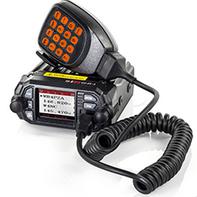VE3LNY's Station
Since I was licensed I have owned and
operated several transceivers: Heathkit SB-100 (bought used, not
built), Drake TR-7, ICOM IC-746, ICOM IC-746PRO, and currently an ICOM
IC-7300. Each radio was sold when the new one was bought, so I don't
keep a collection in the shack.

The IC-7300 is a wonderful rig, and I have enjoyed using it for a
number of years. It has certainly gotten rave reviews on EHAM. I really like interfacing with a real radio,
with the features of an SDR. I have built a project, the ICOM
Commander, to make it quicker to choose the power level and change
the key type.
<rant>
When the radio was new I did not read the manual thoroughly enough, and
left it unpowered for too long. The result was a dead clock battery. This
has been documented thoroughly in the IC-7300
Groups.IO. The original battery (BT381) is a ML414H, 3V
lithium rechargeable, a whopping 1 mAh. The manual says it takes two days
(48 hours?) to thoroughly charge the battery, which may then power
the clock for a few weeks. This suggests a charging current of about 25 uA
(.025 mA x 48 = 1.2 mAh). Looking at the circuit, there is a diode
followed by a 3.3K resistor charging the battery from a 3.3V supply (the
radio needs power but does not have to be turned on).
I have to say that this is a major engineering blunder on an otherwise
remarkably well engineered radio. The battery is surface soldered to the
PC board making it really hard to remove without damage. Then obtaining a
replacement battery is a major challenge depending on where you live.
There are sources in the USA but they do not ship lithium batteries to
Canada. There are sources in Canada that are very expensive compared to
the US price. I found a vendor in China selling a MS621FE battery
(5.5mAh), shipped by surface, for a very reasonable price. The MS621FE
has tabs making it very easy to solder in, once you get the old battery
out. There is plenty of space on the board, ICOM should have used a holder
there.
</rant>
When I sold my 746PRO, I lost 2 meter all-mode. I wanted at least FM
access to 2 the meter/440 mHz bands, so after some research I purchased a
BTECH UV-25X2
mobile radio.

This is a great little rig for the price. The BTech model comes
with an unexpectedly good manual. Programming frequencies using the
microphone keypad is possible but not fun. However using CHIRP
and a home-brew programming
cable (scroll down to mid-page) the job becomes easy.
Unfortunately for me the UV-25X2 maxes out at 25 watts, and I live
in an area with lots of repeaters near and far, and 25W wasn't making it
in many cases. I decided to get a 50 watt rig, and ended up with this
one second hand:

The IC-2730A has been thoroughly reviewed on Eham and Youtube, so I
won't say too much here. It runs 50 watts and gives me access to more of
the distant repeaters. I sympathize with the users that complain about
the lack of mounting hardware, and fortunately mine came with the front
panel bracket I needed. I don't mind purchasing a bracket but my
complaint is the outrageous prices the radio store charges for them and
the programming cable. This is not a new complaint and like buying a car
you have to add up all the options to arrive at the final price which
may be a lot higher.
Speaking of the programming cable, after some research I realized
that the programming port was the same as my old IC-T7A hand-held, which
I had a cable for. The only problem was the ancient cable had a serial
port DB9 connector instead of USB. My old computer has one serial port
so I figured the cable should work like it does for the T7A. I hooked it
all up and using Chirp was easily able to download and upload to the
IC-2730A. Presumably lacking a serial port, a serial to USB adapter
would also work, something I will try eventually.
Back to VE3LNY's Home Page



